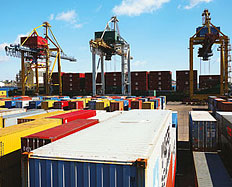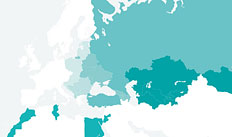Chapter 4
Box 4.4 Cross-border infrastructure
Using a gravity model of trade, this analysis examines the impact of poor infrastructure as a non-tariff barrier to trade, and additionally considers the effect of corruption on the quality of the overall business environment.
To assess the impact of infrastructure on both sides of a national border, the gravity model of trade used to explain export flows from emerging Europe and Central Asia (see earlier in the chapter) has been extended to include characteristics of importer countries as well.
Physical infrastructure in exporter and importer countries is measured using World Economic Forum data that assess the quality of roads, air transport, railways, ports and electricity supply in each country. The variable is expressed as an index and rescaled to vary from -3 to 3, where higher values correspond to better infrastructure. The quality of institutions is proxied by the control of corruption index taken from the World Bank Governance Indicators. It varies from -2.5 to 2.5 with higher values corresponding to lower perceived corruption.
The results (see Table 4.4.1) confirm that bilateral trade flows are explained by the size of economies, geography and effective tariffs. The estimates further reveal that non-tariff obstacles, such as poor infrastructure and corruption, affect trade to a much greater extent than tariffs.
| Dependent variable | (1) | (2) | (3) | (4) | (5) | (6) | (7) |
|---|---|---|---|---|---|---|---|
| Simple average tariff | -0.07*** | -0.08*** | -0.07*** | -0.04*** | -0.04*** | -0.04*** | -0.05*** |
| (0.01) | (0.01) | (0.01) | (0.01) | (0.01) | (0.01) | (0.01) | |
| Exporter GDP, log | 1.40*** | 0.96*** | 1.00*** | 1.26*** | 1.28*** | 1.30*** | 0.88*** |
| (0.06) | (0.10) | (0.10) | (0.09) | (0.09) | (0.09) | (0.13) | |
| Importer GDP, log | 0.46*** | 0.50*** | 0.52*** | 0.39*** | 0.39*** | 0.40*** | 0.49*** |
| (0.03) | (0.05) | (0.05) | (0.05) | (0.05) | (0.05) | (0.06) | |
| Exporter population, log | -0.37*** | 0.20* | 0.16 | -0.18* | -0.20** | -0.21** | 0.34** |
| (0.06) | (0.11) | (0.11) | (0.10) | (0.10) | (0.10) | (0.16) | |
| Importer population, log | 0.46*** | 0.40*** | 0.36*** | 0.52*** | 0.51*** | 0.52*** | 0.33*** |
| (0.05) | (0.07) | (0.07) | (0.06) | (0.06) | (0.06) | (0.07) | |
| Weighted distance, log | -1.83*** | -1.77*** | -1.73*** | -1.94*** | -1.92*** | -1.94*** | -1.87*** |
| (0.05) | (0.05) | (0.05) | (0.05) | (0.05) | (0.05) | (0.06) | |
| Sea coast (exporter) | 0.15** | -0.02 | 0.00 | 0.21*** | 0.22*** | 0.23*** | 0.07 |
| (0.06) | (0.07) | (0.07) | (0.07) | (0.07) | (0.07) | (0.07) | |
| Common border | 0.64*** | 0.60*** | 0.58*** | 0.57*** | 0.57*** | 0.42*** | 0.38*** |
| (0.10) | (0.10) | (0.10) | (0.10) | (0.10) | (0.10) | (0.10) | |
| Control of corruption, exporter | 0.77*** | 0.79*** | 0.83*** | ||||
| (0.13) | (0.13) | (0.14) | |||||
| Control of corruption, importer | -0.11* | -0.21*** | -0.48*** | ||||
| (0.06) | (0.06) | (0.09) | |||||
| Control of corruption, exp*imp | 0.55*** | 0.39*** | |||||
| (0.07) | (0.07) | ||||||
| Infrastructure, exporter | 0.26*** | 0.25*** | 0.28*** | 0.23*** | |||
| (0.08) | (0.08) | (0.08) | (0.09) | ||||
| Infrastructure, importer | 0.21*** | 0.25*** | 0.24*** | 0.45*** | |||
| (0.06) | (0.06) | (0.06) | (0.08) | ||||
| Infrastructures, exp*imp | 0.12** | 0.07 | |||||
| (0.05) | (0.05) | ||||||
| Infrastructure, exp*imp*commonborder | 0.48*** | 0.29*** | |||||
| (0.12) | (0.11) | ||||||
| Constant | -16.35*** | -20.30*** | -20.84*** | -18.51*** | -18.73*** | -18.93*** | -19.36*** |
| (0.59) | (0.68) | (0.67) | (0.71) | (0.71) | (0.72) | (0.77) | |
| Number of observations | 5,457 | 5,229 | 5,229 | 5,112 | 5,112 | 5,112 | 4,884 |
| R-squared | 0.53 | 0.54 | 0.54 | 0.54 | 0.54 | 0.54 | 0.56 |
Source: Authors’ calculations.
Note: Robust standard errors in parentheses. Values significant at the 10 per cent level are marked with *; at the 5 per cent level with **; at the 1 per cent level with ***.
In particular, half a notch improvement in infrastructure on the exporter side (less than one standard deviation) is associated with a 13 per cent increase in trade; a similar improvement on the importer side is associated with a further 10 per cent increase in bilateral trade flows. The effects of infrastructure are symmetrical.
In addition, it is likely that the effect of improvements in a country’s infrastructure on trade may depend on the infrastructure of its trading partners. A new road linked to a highway on the other side of a border may have a strong impact on trade between two countries, while a road link that ends at a border will have no impact on the ease of further transport. Consequently, an interaction term between exporter and importer country infrastructure has been added in Column 5. As expected, it is positive and statistically significant. The coefficients imply that if a partner country has a poor infrastructure, improvements in infrastructure on one side of the border only will have virtually no impact on trade. In contrast, if infrastructure in the partner country is already of high quality, the additional benefits from improving infrastructure are significant: a one standard deviation improvement is associated with a more than doubling of trade flows.
It further transpires that the dependence of trade flows on the infrastructure of trading partners is driven primarily by experiences of countries that share a border and can therefore benefit from direct shipment routes. When the interaction term between source and destination country infrastructure is further interacted with the dummy variable for countries sharing a border (see Column 6), it is this triple interaction term that becomes large and statistically significant. For countries that do not share a border, the joint effect of exporter and importer infrastructure on trade is much smaller and not significant. This probably reflects the fact that trade between non-neighbouring countries may be significantly affected by infrastructure and institutions in third countries through which the goods are shipped.
Furthermore, countries with a higher perceived incidence of corruption tend to export significantly less and import significantly more – which is a serious drag on country growth performance. A one standard deviation improvement in the control of corruption index (0.6) is associated with a 50 per cent increase in exports. This effect is doubled if the destination country has a low level of corruption.29
Apart from its general impact on the economy, corruption often directly determines the severity of non-tariff obstacles to trade. Less corruption, among other things, means more efficient customs and more effective processing of tax refunds – issues that particularly affect the operations of exporters and importers.
29 The coefficient on the interaction term between control of corruption on the exporter side and on the importer side in Column 3 is positive and statistically significant. It is also large in economic terms given that countries with strong institutions have control of corruption indices of around 2.







